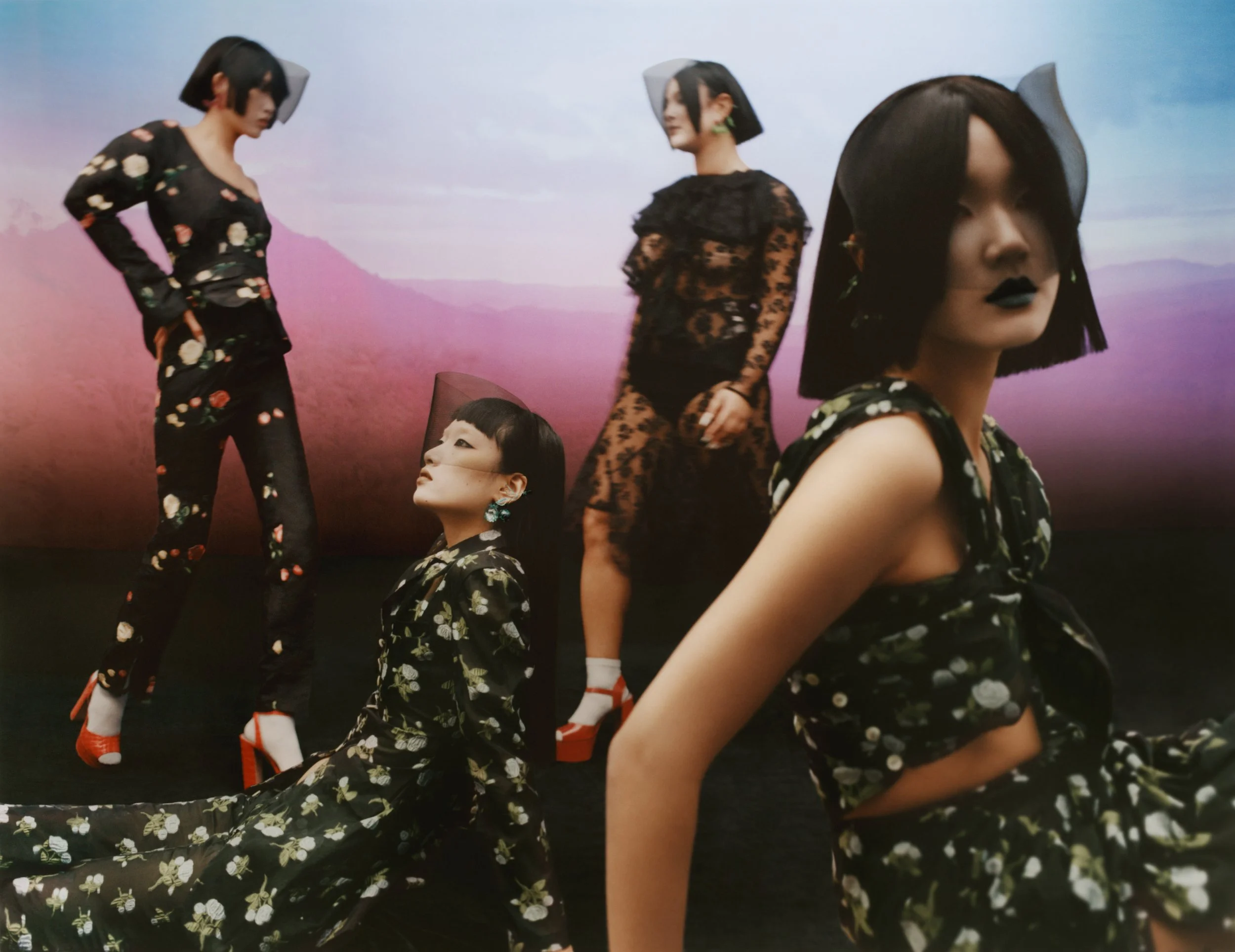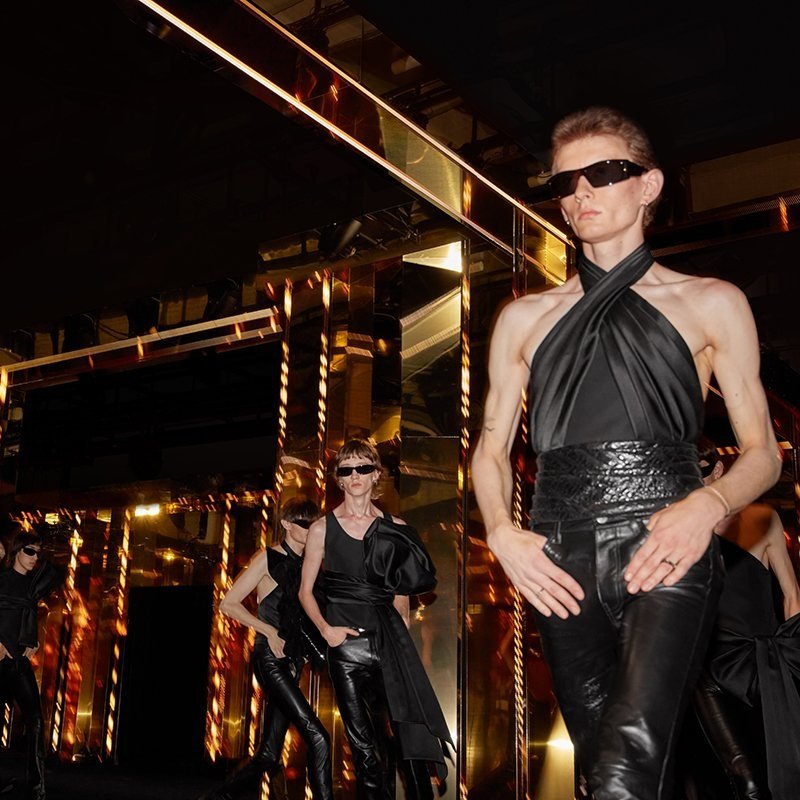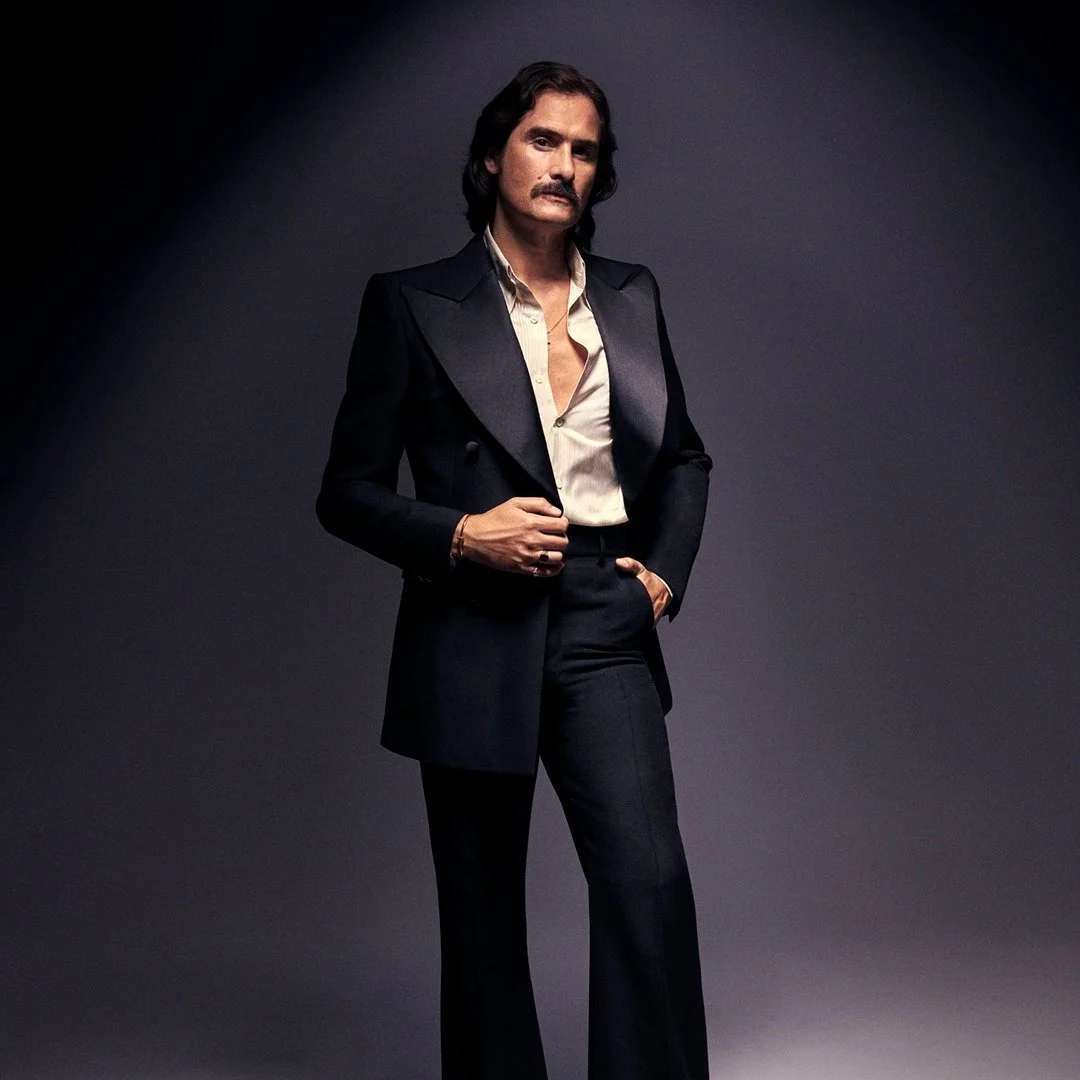Yuhan Wang.
In the three and a half years since her first show on the London Fashion Week schedule, Yuhan Wang has established a sophisticated and precise visual language with her womenswear, a world of satins, sheers, chiffon and lace, of floral prints and textures, often asymmetric and slightly off-kilter – all ruched, gathered, layered and draped to build silhouettes that convey a sense of fortitude and substance as much as delicacy and sensitivity. From one collection to the next, her aesthetic is remarkable in its consistency and coherence. You can trace it all the way back to her womenswear BA show at Central Saint Martins in 2016, where the Yuhan Wang sensibility appeared to glide forth onto the catwalk fully formed in a parade of luxurious loungewear, semi-transparent lingerie and pyjama-style two-pieces. This consistency is more than simply aesthetic, though, driven as it is by the same impulse each season. ‘Through all my collections,’ the designer explains, speaking from her studio in north London, ‘I always want to explore everything that is happening to women nowadays, and to raise people’s awareness of how women are being treated.’
So when Wang started working on her spring 2022 collection, there was one particularly horrific report in the news that preoccupied her thoughts: the kidnap, rape and murder of Sarah Everard by a police officer in March last year. In the days that followed, vigils held in Everard’s name in the south London park where she was abducted, honouring her memory and highlighting male violence against women, were brutally suppressed by the same police force where the murderer served. Hearing the news, Wang says, made her feel ‘angry, sad and really disappointed with the situation of women today, knowing that that could be someone next to you, could be one of your neighbours’. On TV she watched as MP Jess Phillips read out in parliament the names of the 118 women murdered by men in the previous year. ‘That was a very emotional moment for me as well. How could this happen to so many people? And that’s only in the UK. How about the rest of the world?’
She called her spring 2022 show ‘Juliette Has a Gun’ and sent her models out armed with a new addition to the Yuhan Wang range of leather accessories: a holster, its dark form boldly visible against the metres of pale chiffon and decorated with tiny tea-rose motifs. Swathed in white lace and sporting butterfly-print tights, Ella Richards walked out carrying a small golden case shaped like a handgun. ‘I think we need to re-examine the meaning of phrases like “powerful woman”,’ Wang comments. Being powerful, she observes, shouldn’t be a matter of appropriating ‘masculine elements’. ‘It should be about being yourself – that’s already strong enough, I think. We have this kind of softness, very romantic… I don’t think this should be treated as a weakness; it should be our strength. We should be proud of it, and feel comfortable dressing however we like. That’s the thing I try to express most through the collection.
The armed women she looked to for that collection were the European frontierswomen that pushed across North America in the 19th century, their sepia portraits forming part of her research. Wang brings a strong and specific historical element to every collection. Spring 2020, for example, was inspired by characters from The Peony Pavilion, a Japanese romantic stage drama from the 16th century; autumn 2021 took its cue from art-history references a millennium apart, using visual motifs found in Chinese landscapes from the Tang dynasty in a collection inspired by portraits of mothers and daughters by the American impressionist artist Mary Cassatt. Why are these call backs to the past so important to Wang? ‘I think it’s related to my futurism. Because I feel like what we have now and what we will have in the future is all based on what we had in the past.’ It’s a case of knowing where you’ve been to divine where you might be heading. Creating something new, she explains, ‘doesn’t mean you have to imagine something totally different; everything has been done before.’
Today Wang is working on toiles and developing prints for her autumn 2022 collection in her Haringey studio. She moved here a week ago, a new, larger space to accommodate her expanding operation; she already has 17 stockists across three continents and demand from buyers continues to grow. To an outsider, the smooth, steady evolution of her brand through the three and a half years of its existence looks like it must have been masterplanned while she was a student. But in the final months of her womenswear MA at Central Saint Martins, she says, she had no intention of setting up her own label, assuming she would go and work for a big fashion company instead – which she did, landing a job on the womenswear design team at Marni. It was while she was still in London after graduating, waiting for the paperwork that would allow her to work in Milan, that she was invited by Fashion East to present a collection during London Fashion Week. ‘I didn’t have much to do. So I was like, do a show? Yeah, fine – just enjoy it.’ She laughs. ‘I didn’t think about it properly as a company, how I was going to operate it and produce it.’ And then, after starting at Marni, she continued to present each season in London, working on her own brand in her time off. ‘Like a hobby,’ she says modestly. This double life led her to conclude that ‘what I wanted to do most was to do my own thing’.
In order to devote herself to her own brand entirely, she moved back to London at the start of 2020, only to be met by an even bigger hurdle: the global Covid-19 pandemic. First her supply chains in China ground to a halt, then the UK was placed under lockdown. ‘You just get used to it,’ she says matter-of-factly. ‘When you create a collection, you have to figure out, if this cannot be achieved, what’s your plan B, your plan C?’ It helped that her label was still small and agile enough to let her create a show collection alone during lockdown. ‘Because I’ve done everything in the past by myself, I’m familiar with each step. I can draft the patterns, do the draping, I can stage… So it’s not a big problem for me to work at home on a domestic sewing machine.’
Ironically, it was the technical discipline of drafting patterns that had put her off studying fashion when she was younger. Fashion was a subject she always had some interest in, all the way back to her childhood in the port city of Weihai in Shangdong province, China. ‘I think lots of little girls probably have this experience: playing with dolls with their sisters, using bits of scrap paper, folding it and twisting it to dress the body. I think that was the beginning, even though you don’t think of that in terms of fashion.’ As a teenager she would read Vogue and sketch clothes: she had a particular interest in the historical outfits she saw the actors wearing in costume dramas on TV. But once she started to study fashion formally, the pattern-cutting classes put her off. ‘I didn’t enjoy the technical aspects – the mathematics, all those calculations!’ Instead she transferred to a graphic design degree course in New York, where her sister was working as a lawyer. She briefly considered studying sculpture because she enjoyed working in 3D. ‘But I chose graphic design because I thought it would be more practical – it’s easier to find a job after.’
Her time in New York coincided with the arrival of the epic Alexander McQueen: Savage Beauty exhibition at the Metropolitan Museum of Modern Art. She lost count of how many times she went to see it – ‘five, I think’ – queueing for at least an hour each time: ‘I was really impressed by his work.’ What was the appeal for her? ‘It wasn’t only about the clothes – it’s the atmosphere, the emotions… something inside that you can’t explain.’ As cameras were forbidden in the exhibition, she would take along a sketchbook and sit in the galleries drawing looks. ‘That inspired me a lot.’ She heard some representatives from Central Saint Martins, McQueen’s alma mater, were visiting the city. ‘I thought, why not just take my portfolio to show them, just to get some feedback on it? That’s all I wanted. And they gave me an offer for womenswear!’ She wasn’t even required to attend foundation year. ‘It was like a dream.’ Even so, she deferred for her place until she’d completed her graphics degree, which she says remains useful to this day. ‘It definitely helped my visual balance. And I still draw all the prints myself.’
Right now, as we speak, Wang is planning a show for her next collection, even though at this point the pandemic still threatens the scheduling of London Fashion Week in February. While an enforced absence from the catwalk has led some young designers to question whether they need to stage a show at all, Wang’s commitment to the live event is resolute. ‘I definitely like people sitting there seeing the movement of the clothes, the texture, the emotion.’ With the online alternatives, she observes, there are limits. ‘Even if you shoot great images, people don’t feel so much; there’s no interaction. If you want to express your brand’s culture and what you’re trying to introduce to your community, I think the show is the best way.’ Has she ever been tempted to expand that culture to accommodate menswear? She pauses. ‘Hm. Maybe in the future.’ There are boys who already buy her clothes, she says. ‘So there is a market. But it would take time… I’m not sure. The reason I’m doing womenswear is because I’m a woman; I understand women more than men.’
For now, her experience of life as a woman remains crucial to everything she creates. Her work is supremely personal – although the world of Yuhan Wang is not restricted to her own requirements as an individual. ‘I don’t limit it to my own wardrobe,’ she says, not least because ‘since I became a fashion designer I haven’t had much time to really dress myself. I enjoy dressing others more than dressing myself. I kind of draw a woman’s figure in my mind. That’s the woman I’m trying to show to people, the woman inside myself. And that isn’t limited physically to how I look – it’s something from me, something that’s part of me.’















